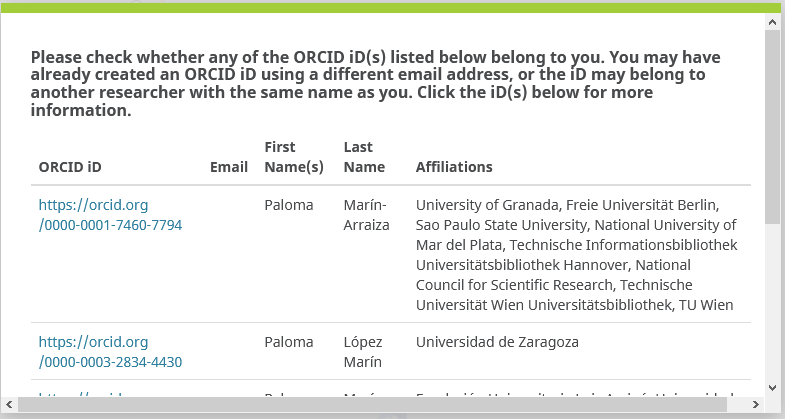FREQUENTLY ASKED QUESTIONS
General
This was a problem with ORCID for a long time, as institutions could create IDs for their employees without permission. Nowadays it is no longer possible to have two or more iDs because the ORCID system automatically alerts you to possible duplicates when another iD is registered. The ORCID system communicates with other systems like the databases Scopus, Web of Science or PubMED, DOI providers like DataCite or Crossref and search engines for scientific open access works like BASE or Redalyc. The ORCID system also offers an automated collection of information from these systems and aggregation into ORCID records. This functionality can be found under “Work > Add Works > Search&Link”. If this option is set to active, the ORCID record is updated automatically. After each update of the ORCID record, the user receives a message with information about the changes. The information can also be entered manually, or the persistent identifier (DOI, PubMed ID, ArXiv ID) of the work can be used to assign the work directly to the ORCID record with one click. If the same work is exported to ORCID from different sources (e.g. from an institutional repository and a scientific journal), duplicates can be found. To solve this, ORCID has introduced the “Combine” functionality, which allows combining two works in one record. 




Consortium
Every institution which is based in Austria, organised according to Austrian law and from one of the following fields may join the consortium. While for-profit organisations may become members of ORCID, their membership in the consortium is prohibited. Further information about ORCID membership possibilities may be found here. The consortium is subject to the tiered fee model, the price of which is dependent on the number of consortium members as well as on the annual budget of the member organization. You find detailed infomations on the ORCID website: https://info.orcid.org/membership/ It is possible to join the consortium at any time. Steps for becoming a member: Yearly membership: Membership during any given year lasts from 1 January until 31 December. However, if an institution joins the consortium at another time throughout the year, the costs of membership will be reduced proportionately. ORCID Member Reports are on-demand and contain insightful data about how integrations are being used, such as how many researchers have connected their iDs to an integration, and how many records have been updated via the integration. ORCID members have access to two reports that offer insightful data about both members and integrations: You can access these reports via the ORCID Member Portal: https://info.orcid.org/documentation/member-portal/
Our consortium consists of 20 members (2023).
Therefore the annual costs for the Small Tier (below US$ 10M) is US$ 2,150, for the Standard Tier (US$ 10M – 1B) is US$ 4,250 and for the Large Tier (above US$ 1B) is US$ 5,750.
Technical implementation
Possible integration points are described on the ORCID website.
ORCID provides an application programming interface, or API, which allows other systems and applications to connect with the ORCID registry. ORCID has a collection of the most frequently asked questions regarding the use of APIs (API FAQs). We have listed a few of the most important here. The answers may lead to further resources on using the API.
The public API is available to anyone registered with ORCID and therefore also to institutions and non-members of ORCID. The public API can be used to verify researchers, as well as for searching and viewing public data from the ORCID records of researchers.
The member APIs (basic and premium) allow institutions, with the consent of researchers, to authenticate, to access read-only information (trusted data), to edit ORCID records and to update.
Further resources can be found under the following links:
- ORCID Member Support Center (info about the public API)
- ORCID Member Support Center (info about the member APIs)
- ORCID API user group (Google group)
- ORCID membership comparison (public API, basic API und premium API)
Some systems already support integration with ORCID automatically.
These include, for example:
- Repositories:
- DSpace
- EPrints
- CRIS systems
- Elements
- PURE
- DSpace CRIS
- Publication systems
- Open Journal Systems
A complete list can be found here: ORCID-enabled systems. Integration with ORCID is also possible in other systems, but only those solutions which are currently made available via ORCID and the community are listed above.
Yes. The website offers a selection of model workflows for the integration of ORCID. Currently, the information pertains to the integration of ORCID API 3.0 and 2.0. As of 1 September 2019, Version 3.0 will replace Version 2.0.
Data protection
ORCID adheres to the General Data Protection Regulation (GDRP) and places great importance on data protection laws. Furthermore, the data protection practices of ORCID are based on three levels of openness and protection (everyone – public, trusted – limited access und only me – private), which are always stipulated by the individual researchers.
„Trusted parties” are organisations or individuals who have access to the ORCID records of a third party. Depending on the type of access, the trusted party can read and/or edit ORCID records. Revoking the right to edit or transfer is possible at any time via ORCID account settings on the ORCID platform.
ORCID retains data for as long as an account is active, or as long as needed to provide services, including reactivation. (ORCID Privacy Policy, section 9.2). After the reactivation of an account, ORCID saves a cryptographically hashed form of the email (ORCID Privacy Policy, section 7.0) and the ORCID iD. All other information pertaining to this iD (name, for example) is deleted from the registry.
Data is stored using the services of Rackspace with backup in Ireland
Yes. As part of the ORCID DE project, the DFG entrusted the law firm iRights.Law to perform a data protection assessment with the title „ORCID from a data protection perspective,“ which shows the many ways in which ORCID is setting high standards in this area. The full assessment is available here: http://doi.org/10.2312/lis.17.02.